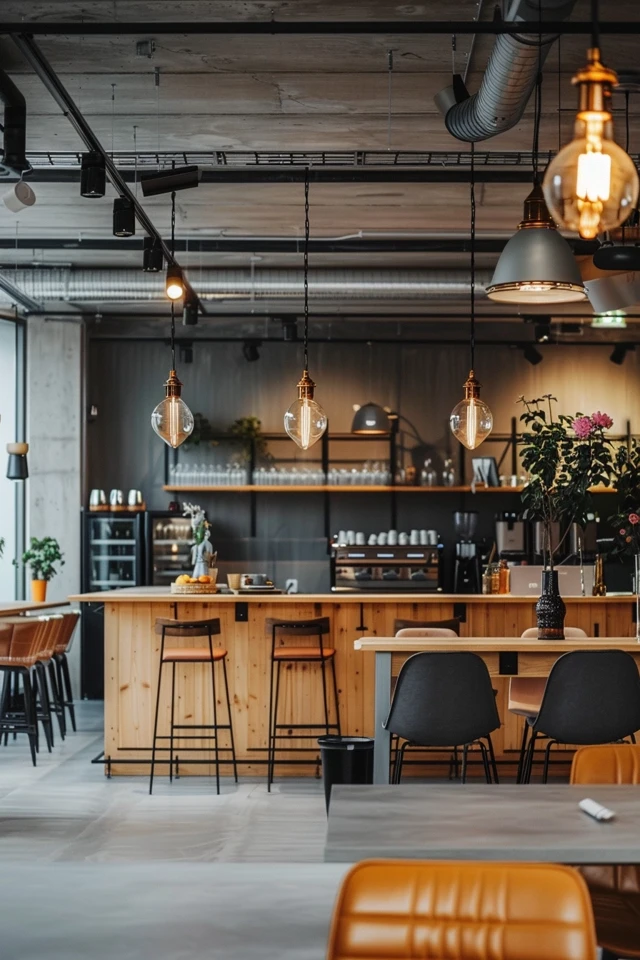Industrial interior design blends old and new for a cool, edgy look. It’s all about keeping things simple and practical, with few decorations. The ceiling is a key part of getting that industrial vibe right. Here’s how to nail your industrial ceiling design:
1. Enhance the Raw Look with Building Materials
This style loves showing off a place’s original feel and history. Use materials like visible beams and metals to get that look. Don’t hide pipes and ducts; let them be part of the style.
2. Incorporate Excellent Acoustics
Sound can bounce around big open spaces, making echoes. Acoustic ceilings reduce noise, making the area more comfortable. Look into options like Rockfon Eclipse®, Rockfon Contour®, or Rockfon® Universal™ Baffle. They come in various shapes and colors, fitting right in with an industrial design.

3. Play with Contrast
Make your industrial space stand out by mixing things up. Pair old, rustic pieces with modern, metallic features. Imagine using old pipes as quirky hangers for coats or bikes. This mix adds layers and personality to your place.
4. Make a Bold Statement
Show off the building’s bones with industrial ceiling design. Let the structure and machinery be seen. It embraces the industry’s gutsiness and makes your area special and striking.
5. Enhance the Lighting Fixtures
Good lighting can change a room’s feel, making it brighter and cozier. Go for big, bold lights that match the industrial theme. Trying out various lighting setups can really perfect the look and feel of your space.
Key Takeaways:
- Industrial interior design combines the past and present, creating a raw and edgy aesthetic.
- Enhance the industrial look by using building materials that expose architectural elements.
- Acoustic ceilings can improve sound absorption and create a comfortable indoor environment.
- Play with contrast by mixing rustic furniture with pipes and metallic surfaces.
- Industrial ceiling design reveals structural and mechanical details, creating a unique space.

Enhancing Building Materials
Industrial interior design celebrates the
unfinished look
and
architectural legacy
of a space. It embraces
simplicity
and
minimalism
. Decorative touches are minimal to highlight exposed ducts and pipes. This style aims to keep the building’s original charm. It lets the building’s raw beauty shine.
Designers use certain materials to boost the industrial vibe. Think concrete, exposed brick, metal, and reclaimed wood. These add authenticity and character. They respect the building’s past while looking cool.
The design’s simplicity focuses on what makes the space unique. Without extra decor, things like structural beams stand out. It’s all about honesty and being true to the building’s roots.
Add character with unexpected details. Maybe hang a bike or display coats on old pipes. It makes the space fun and inviting. These touches boost the aesthetics too.
In summary, the right building materials underline the key themes of industrial design. Themes like the unfinished look and a nod to the past. By showing off a space’s raw beauty and adding unique details, designers craft visually appealing, character-rich spaces.
Improving Acoustics
In industrial-style spaces, controlling sound is key. Large, open areas can echo, making it hard to talk or concentrate. Choosing the right materials is essential to cut down noise. Many options work well with industrial design to make spaces sound better.
Acoustic Ceiling Tiles
Acoustic ceiling tiles play a big role in better acoustics. These tiles soak up sound and lessen echo. They fit right into industrial ceilings with various styles.
These tiles lower the noise by catching sound waves that would otherwise bounce around. This makes rooms quieter and more comfortable for everyone.
Fabric Wrapped Acoustical Panels
Walls can also absorb sound using fabric wrapped acoustical panels. They’re great for cutting down echoes and unwanted noise in big spaces.
Putting these panels on walls stops sound from bouncing off hard surfaces. This lowers noise levels and makes the place sound nicer and feel cozier.
Pros can offer customized advice on echo reduction in large, high-ceiling industrial areas.

Suspended Ceiling Clouds
Suspended ceiling clouds are another way to improve sound. These panels look good and help control noise. They can be arranged in cool patterns to add to the room’s style while making it quieter.
They not only add beauty but are great at absorbing sound too. Putting them in the right spots helps balance the sound in a room, reducing echoes.
Insulation and Floor Treatments
Putting insulation or noise-reducing foam between floors helps quiet sounds from above. This is good for controlling footsteps and other noises from upper levels.
Floors can also be covered with carpets or rugs to stop noise. This keeps sound from bouncing off hard floors, making the space more sound-friendly.
By exploring these options and working with sound experts, designers can make industrial spaces better sounding. Improved acoustics make places nicer and healthier for everyone there.
Playing with Contrast and Creating a Storytelling Space
In the world of industrial interior design, mixing different styles is key. By putting together vintage furniture and modern elements like bare pipes and metal, we get an exciting mix. This mix of the old and new gives a room depth and personality.
The ceiling design in these spaces plays a big role. It shows off the structure of the building in a bold way. The ceiling tells its own story, adding intrigue and leaving room for creative design.
Yet, it’s not only about looks. Functionality is essential, too. Industrial design values big, open spaces and keeps things simple. By choosing the right materials, the space’s unique vibe is kept alive. Using different materials, like warm wood and cool metal, adds to the space’s feel. It brings together the best of both worlds.
Summing it up, industrial design is all about bold mixes. Combining old-style furniture with industrial features creates an appealing contrast. Ceiling design helps tell the story of the space, allowing for creativity. By using contrasting materials, the design is not just interesting to look at but feels right. It brings out the true spirit of industrial style.

